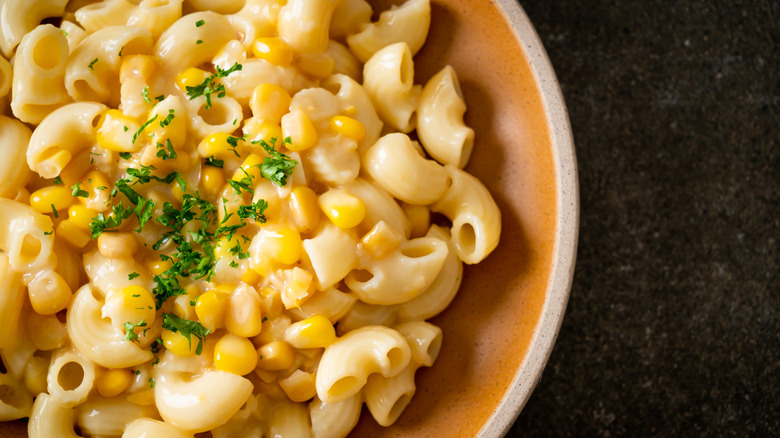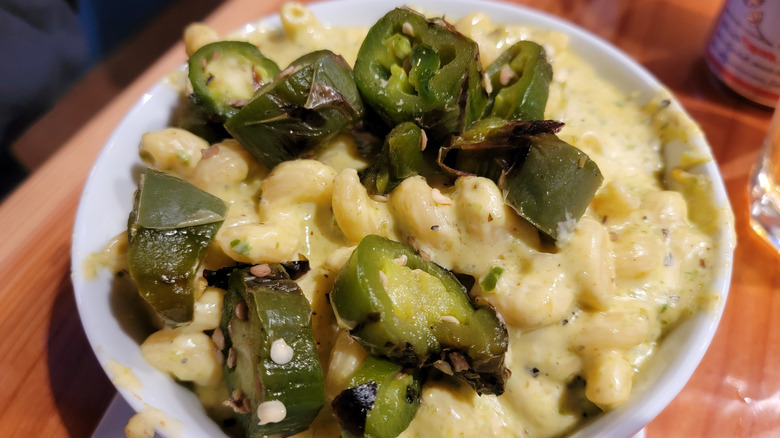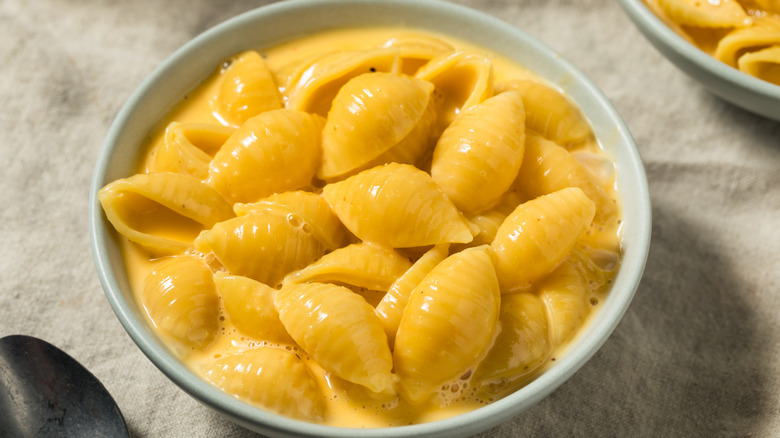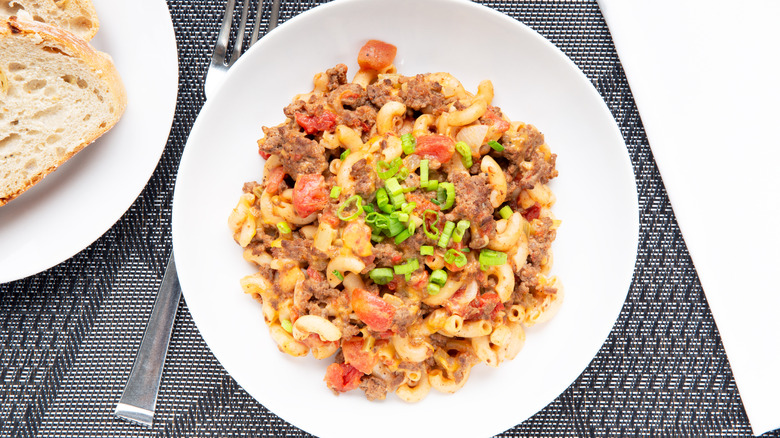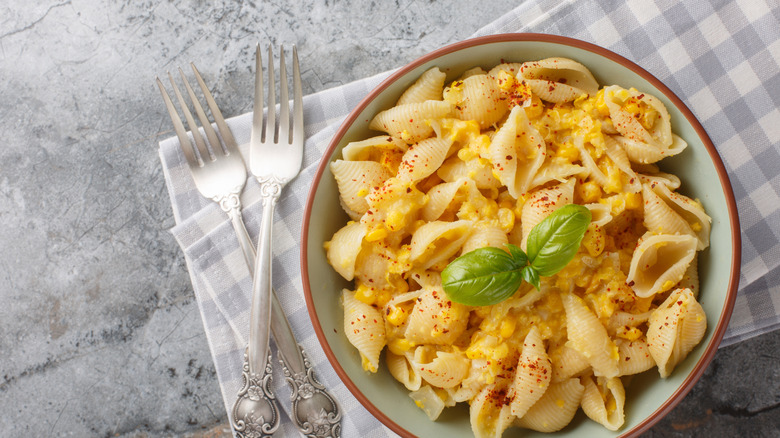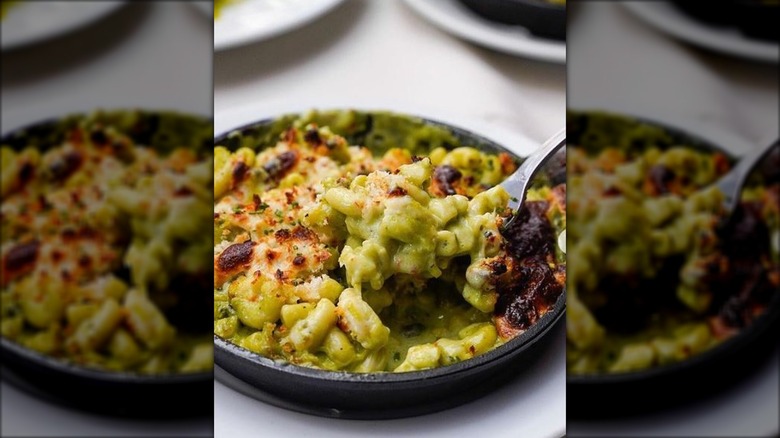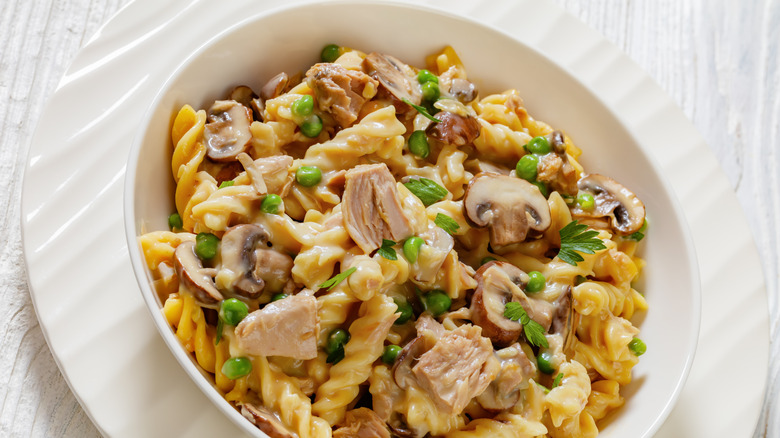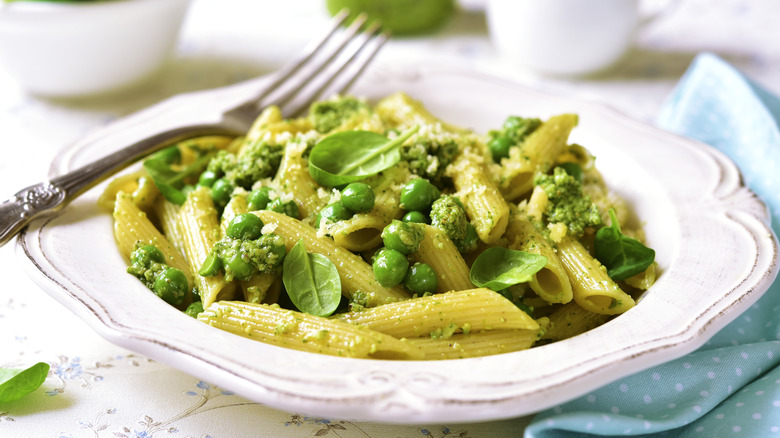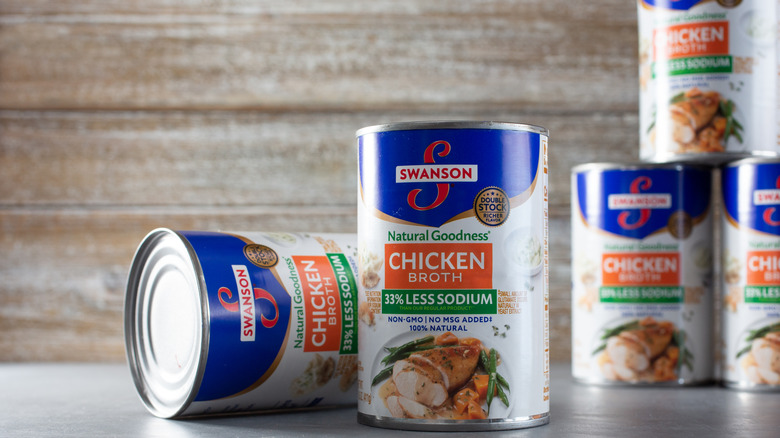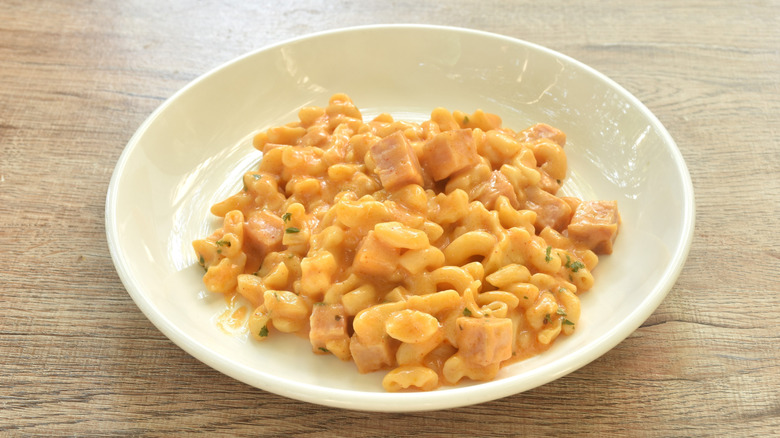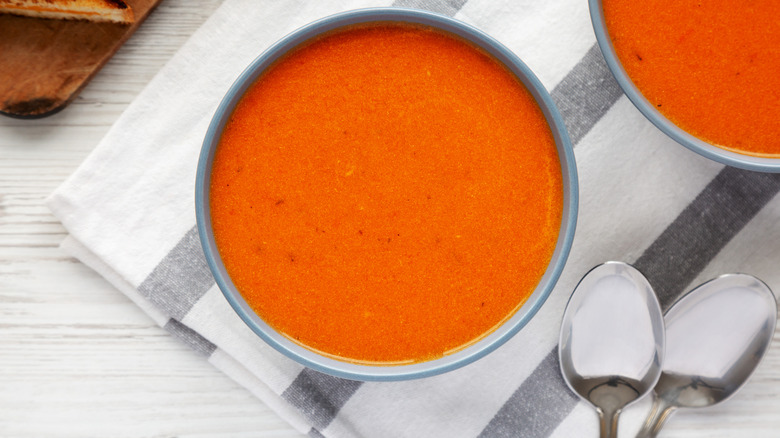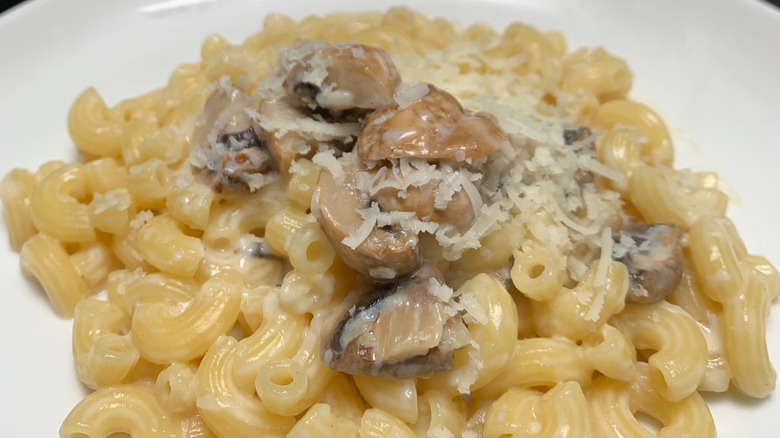Canned Ingredients That Will Take Your Mac And Cheese To Another Level
We may receive a commission on purchases made from links.
Let's face it — mac and cheese is good, but there are times when you just get tired of eating the same old thing. We hear ya. Still, infusing mac and cheese with new and delectably unusual flavors often takes work — and if you're anything like us, there are some nights when adding extra steps to your recipe is the last thing you wish to be doing.
Thankfully, it's easier than you may think to get your fill of mac and cheese in fun and interesting ways. Utilizing canned ingredients in your mac is a quick and easy method for achieving flavor without the hassle. From meaty additions to spicy mix-ins, we're exploring the many ways you can give your mac a makeover. In the upcoming post, you'll not only learn about the canned ingredients that complement macaroni and cheese, but also how to go about using them to achieve cheesy perfection. So, if you're ready, let's explore a selection of ingredients you can add to your macaroni and cheese to yield delicious results.
Canned jalapeños
If you love jalapeños and cheese dip, you'll probably dig this flavorful spin on mac and cheese. Adding canned jalapeños to your mac not only gives it a spicy kick but studs it with a contrasting green color that makes it just as fun to look at as it is to devour.
Using canned jalapeños in macaroni and cheese is easy — in most cases, you'll simply drain the jalapeños and throw them into your cheese sauce right before the noodles. For even more pizzaz, consider sautéing your jalapeños along with a bit of onion and diced bacon. After cooking, remove these ingredients from your pan before making a cheese sauce in the same vessel for extra flavor. Finally, toss your previously sautéed ingredients back into the sauce along with the cooked noodles before continuing with your recipe as desired.
Don't forget to reserve some of the brine the jalapeños came floating in; pouring a little into your cheese sauce can inject it with even more spicy flavor, though just how spicy your jalapeños will be will depend on the brand and other factors.
Canned evaporated milk
Canned evaporated milk is a worthy ingredient to consider including in your mac and cheese. Thanks to its composition, using it can lead to utterly creamy results. Evaporated milk contains milk protein micelles, which act as emulsifiers, leading to a smooth and delicious cheese sauce. Because of its creamy characteristics, you only really need three ingredients to pull off a decadent mac and cheese: cooked elbow macaroni noodles, your choice of cheese, and of course, canned evaporated milk.
To use evaporated milk in this dish, start by boiling the noodles. Be sure to salt the water well and to only use enough water to cover the noodles. Using this technique helps the noodles stay starchy, which simultaneously helps the cheese cling. Once the noodles are cooked and have absorbed the majority of the water, add a good amount of evaporated milk (roughly the same amount as the dry macaroni noodles used) along with an equal amount of cheese. Stir to combine and serve warm.
Of course, the above-suggested method for adding canned evaporated milk to macaroni and cheese is only a base recipe — feel free to jazz it up with the ingredients of your choice. Mix-ins like bacon, butter, hot sauce, or jalapeños can help make this dreamy stovetop mac and cheese your own.
Canned tomatoes
You won't normally find a can of tomatoes as part of the ingredients in a mac and cheese recipe, but that doesn't mean it isn't a delicious idea. We get that it's odd, but cheese and tomatoes go way back, even showing up as the star ingredients in pizza, making the addition of canned tomatoes in your next bowl of mac not quite as weird as you thought.
There are multiple types of canned tomatoes you can employ in macaroni and cheese. The first option is to use canned tomato sauce. Though unconventional, this ingredient can infuse a layer of flavor that complements other non-traditional add-ins as well. Try ground beef, ketchup, Worcestershire sauce, cheddar cheese, and a few seasonings alongside the tomato sauce to enjoy the flavors of a sloppy joe infused directly into your mac.
If that sounds a little too adventurous, try taking the easier route. Stir a can of drained stewed tomatoes into your cheese sauce. Once assembled, bake your tomato-studded macaroni and cheese in the oven until the tomatoes are warmed through and the top of your macaroni and cheese is golden brown. Of course, you can experiment with other types of canned tomatoes as well — fire-roasted varieties, such as Hunt's Fire Roasted Diced Tomatoes, can provide smoky tomato goodness in every bite. Experiment and see which canned tomato option works best for you!
Creamed corn
Ever find yourself mixing your side dishes together on your plate? Why not save yourself the hassle and mix them ahead of time? Combining creamed corn with macaroni and cheese might seem like an odd mashup, but it's actually very good. Because creamed corn is already, well, creamy, it blends in seamlessly while providing a pleasant albeit unique texture to your macaroni and cheese dish.
When using creamed corn in macaroni and cheese, combine it directly with the cheese sauce. If you're using a product like Velveeta cheese sauce pouches, you can simply dump in your creamed corn, heat, and serve. For even more texture and flavor, add a can of regular corn. Do keep in mind the consistency of your cheese sauce before incorporating corn — a runnier sauce may benefit from canned corn that has been drained first, while thicker sauces, including processed cheese sauce, may benefit from leaving the corn undrained.
Remember that corn is often naturally sweet, and creamed corn usually contains added sugar. Because of this, you may notice that using corn in your macaroni and cheese gives it a sweeter flavor. To offset the sweetness, consider adding chopped bacon or ham — the salt in these meats provides balance that may make the dish more satisfying to your taste buds.
Canned green chilies
Green chilies have an herbaceous earthiness that makes them the perfect companion to luscious mac and cheese. The nice thing about this ingredient is that, in most cases, canned green chilies come in varying levels of heat, with hotter flavors like these Amazon Fresh Hot Green Chilies or a mildly spicy version like these Amazon Fresh Mild Green Chilies, making it easy to adjust the spice level of your mac to your liking.
When adding canned green chilies to macaroni and cheese, drain the liquid before mixing them into warm cooked cheese sauce. From there, combine the chili-infused sauce with cooked macaroni pasta and serve right away, or top your mac and cheese with breadcrumbs (be sure to note the difference in texture between panko and traditional breadcrumbs) before transferring the dish to the oven to bake.
Oh, and one more thing. Though cheddar cheese is the usual go-to for most mac and cheese lovers, other types of cheese complement the flavor of canned green chilies just as well. Consider adding Monterey Jack instead of cheddar, along with a sprinkle or two of cumin and smoked paprika. Looking for more heat? Layer in some pepper jack cheese along with a few sprinkles of crushed red pepper for your spiciest rendition of mac and cheese yet.
Canned tuna
If you've never tried mixing tuna into a bowl of mac and cheese, you're in for a treat — assuming you like tuna, that is. Reddit is littered with posters reminiscing on simpler times when tuna with mac and cheese was a childhood staple. With the help of a few veggies like celery, diced carrot, or peas, this combo easily converts from tasty side dish to a full-blown meal all on its own.
Though you can totally throw a can of tuna into a homemade mac, there are many recipes that involve a simple box of high-quality macaroni and cheese. When adding tuna to boxed macaroni and cheese, first make the mac according to package instructions before adding butter for extra creaminess, followed by a can of drained tuna. If you're in the mood for extra ingredients, try tossing in some sautéed mushrooms, broccoli, or the previously mentioned celery, peas, or carrots. Want more crunch? Feel free to top this no-fuss tuna mac with breadcrumbs before digging in.
Canned chipotles in adobo sauce
Canned chipotles in adobo sauce are a great ingredient to use in macaroni and cheese, though thismay not be for everyone. They definitely bring the heat in terms of spice and pack loads of complex flavor; in fact, you really only need one or two peppers to achieve those coveted sweet, smoky, and tangy chipotle results.
When using canned chipotles in adobo sauce to your mac and cheese, you can choose to sauté the peppers before adding them to your cheese sauce or, if you prefer, give them a whirl in your blender until they become one with the sauce. If you choose to take the blender route, be sure not to start blending heavy cream by itself, or else it may result in a texture that resembles dessert-style whipped cream.
Once you've mixed the canned chipotles into your cheese sauce, continue with your recipe as usual. As always, feel free to switch up the cheese when attempting spicier variations of mac and cheese — Monterey Jack is a great addition, though traditional cheddar cheese works just as well. Don't forget other fun and flavorful ingredients like fresh garlic, paprika, and onion powder; though unconventional, these work to amp up the flavor of mac and cheese all the more.
Canned peas
This cheap and widely available canned ingredient adds a beautiful pop of color while offering nutrition to boot. Though it may seem boring at first, when combined with other yummy ingredients, it can bulk up your mac and cheese in an interesting, non-traditional way.
When adding canned peas to mac and cheese, try to do so near the end of the cooking time. If you place them in the cheese sauce too early, you may risk turning them to mush and having them separate from their shells once heated. The same is true for over-mixing — be sure to stir your mac and peas slowly so as not to break these delicate orbs apart.
If slowly stirring canned peas into your mac and cheese sounds like too much of a chore, you could try the alternate route by substituting the milk in your mac and cheese for pureed peas. To make the pea puree, combine canned peas with milk and give it a whirl in a blender. Use the final puree in your mac and cheese to reap the benefits of the veggie without having to deal with individual pea pieces. Keep in mind that using a pea puree will likely turn your entire mac green, making it a great option for picky kids who might not eat the veggie otherwise.
Canned chicken broth
Canned chicken broth in mac and cheese? Yep, and we aren't taking it back. Not only can adding chicken broth to mac and cheese help thin your cheese sauce, but it can also introduce a savory flavor to the dish that you just might love.
There are many ways to utilize chicken broth as an ingredient in macaroni and cheese; our favorite is to cook the noodles in a mixture of broth and water along with a few seasonings. Once the noodles are cooked, add the milk and cheese of your choice and stir. Alternatively, you can consider pouring a bit of chicken broth directly to your cheese sauce to make the sauce thinner and smoother while infusing it with tons of umami flavor. Of course, those are only a couple of options — feel free to switch things up as you see fit.
Lastly, remember that chicken broth can be quite salty, and as such, you may wish to use a low-sodium chicken broth in your mac and cheese to help you better control the salt content, such as Swanson Low-Sodium Chicken Broth.
Spam
Got more Spam on hand than you know what to do with? Might as well put it to good use! This salty combination of pork and ham has a flavor similar to bacon or bologna (though rest assured, bologna and Spam are not the same), which helps add meaty flavor to macaroni and cheese without breaking the bank.
Using Spam in mac and cheese is easy, though ideally, you'd cook the Spam before using it. To do so, either fry it in a skillet until crispy or place it under the broiler until golden brown. Once cooked, dice the Spam and toss it into your cheese mixture. Stir in noodles, heat through, and serve warm.
When seasoning your macaroni and cheese, keep in mind that Spam is quite salty, meaning you may need to pull back on seasonings a bit to keep from overpowering the dish. Don't forget to explore a variety of Spam flavors; options like Hot & Spicy Spam can endow your mac and cheese with even more delicious taste.
Canned soup
You probably think we're off our rocker at this point, but adding soup to mac and cheese isn't as novel an idea as you might think. Though admittedly unusual, the Reddit community is filled with posters who have tried out this less-common canned ingredient in their mac with pleasing results.
There are many types of soup you could try adding to mac and cheese. Though tomato soup is one of the most popular, others like condensed cream of mushroom soup and condensed cheddar cheese soup, are viable options as well. So how should you go about incorporating it into your next bowl of mac? That'll depend on the type of soup you're using. In the case of cheese soup, simply cook your noodles, drain them, and toss 'em in your condensed cheddar cheese soup along with a bit of milk and the shredded cheese of your choice before baking. Want more tomato flavor to savor? Consider adding tomato soup to a small pot along with milk and Velveeta cheese to taste. Toss cooked and drained macaroni noodles into this mixture for a quick and easy mac chock-full of tomato flavor.
Canned mushrooms
We've already noted the benefits of adding cream of mushroom soup to your macaroni and cheese, but using plain canned mushrooms is just as good. Canned mushrooms won't add the creaminess to your dish that cream of mushroom soup does, but they still impart plenty of distinguishing texture and flavor to make them an ingredient worth exploring.
When making mac and cheese with mushrooms, you may wish to cook the mushrooms ahead of time (here's the very best way to sauté mushrooms), to give them an opportunity to brown while allowing you the chance to season them as you choose. Once cooked, stir the mushrooms into your mac and cheese sauce and proceed with the recipe as usual.
Remember that because of the unique flavor of mushrooms, it can sometimes help to switch up the type of cheese you use. We recommend using Gruyère as part of your cheese sauce base, or even a blend of Gruyère and cheddar. Don't forget to experiment with other complementary flavors — ingredients like thyme and shallot can help take an ordinary dish of mac and transform it into a mushroom-enriched treat full of rich, satisfying flavors.
Canned pumpkin
Got a can of pumpkin puree? Try using it to make mac and cheese instead of pie this fall season. Pumpkin mac and cheese is a delicious way to utilize pumpkin in a way that's both filling and delicious. It brings a level of creaminess, warmth, and golden color that's perfect for colder months. And while totally optional, incorporating interesting additions, like DIY pumpkin spice and cream cheese, yields a surprisingly upgraded mac you could have never imagined would be so good.
There are a couple of ways to use canned pumpkin in mac and cheese. The first is to pour it directly into your cheese sauce before combining it with cooked noodles. The other is to mix a can of pumpkin puree with water and a few seasonings like garlic and pumpkin spice in a pot. Add dry macaroni noodles and cook until tender, then stir cream cheese into the mixture until melted. Reduce the heat to low and mix in your choice of shredded cheese — Parmesan and cheddar tend to complement the flavor of this pumpkin-infused pasta well. As for the results? Expect a marvelously rich and golden mac and cheese that's bursting with flavor and perfect for indulging in on chilly autumn evenings or cold winter nights.
